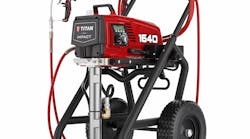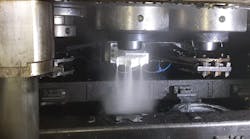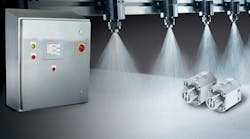Last year, I had the opportunity to walk the full manufacturing works of a third-tier automotive component supplier in North Carolina.
In a lot of ways, the plant perfectly reflected the state of the auto supplier industry. It was rushed and hectic, working far over capacity 24 hours a day, seven days a week to meet impossible demands.
The rural plant had trouble bringing in new workers with the skills it needed, so what staff it had were all literally running through the plant, tending multiple machines, performing multiple, diverse jobs while dodging fork trucks racing at full speed across the floor to load delivery after delivery to Detroit.
As you could imagine, this frantic concentration on productivity left critical jobs—such as safety, maintenance, and strategic planning—almost completely ignored.
One aspect of this, you could say, stuck with me for days.
The plant used an air atomizing spraying system to lubricate its parts for final assembly, misting the oil into a fine particle cloud to ensure that every inch, nook, and cranny of its components was adequately covered.
In the process, the company also ensured that every inch of floor, every machine, and every human in the plant was also slathered with the stuff. Oil was dripping from the ceilings and from every power outlet; there was a visible cloud of oil hovering from floor to ceiling of the place.
By the time I left, I was covered in a thick film of oil. My shoes slipped with every step for days, my clothes reeked, and worse, my lungs were absolutely coated. In two hours, I collected enough oil in me for a week-long cough.
It was, to put it mildly, a miserable—though nonetheless interesting—experience.
This year, I have written a long series of articles on hydraulic spraying systems that are designed to prevent these kinds of excessive (and dangerous) misting practices, highlighting these incredible systems that can increase accuracy and quality while lowering waste and cost.
But these positive results aren't restricted to hydraulic atomizers alone.
Under the right conditions and with the proper set-up, air atomizing systems can offer the ideal solution to keep plants and operations running smoothly while eliminating bad misting effects entirely.
To find out what conditions make air atomizers the right choice and how to set them up for success, we checked in with Scott Hoffmeyer, a design engineer at Spraying Systems Co.
NED: First the basics. What is the difference between hydraulic and air atomizing systems?
HOFFMEYER: Let's start with atomizing itself. Atomizing is just the breaking up of a fluid stream into drops or particles. The only way to atomize a fluid like this is to put energy into it. There are two primary methods for accomplishing this. Nozzles either atomize hydraulically using fluid pressure or use compressed air to break up the fluid. That's air atomizing.
NED: We’ve covered a lot of the advantages of hydraulic systems in the past. What advantages do air atomizers offer over these?
HOFFMEYER: First, air-atomizing nozzles can usually generate much smaller droplets than hydraulic nozzles.
When spraying hydraulically, the only way to get very small drops is to use extremely high pressure, usually somewhere in the 500 to 5,000 psi range. If you go that route, you are talking about a significant investment in pumps.
If you want really low flow rates with the combination of smaller droplets, you are looking at large pumps with very small nozzle orifices that can easily clog.
Air atomizing lets you use much larger nozzle orifices that don't clog as easily, but you still break those liquid streams into significantly smaller drops.
Another reason why you would choose an air-atomizing nozzle is if you want to spray a highly viscous fluid—something that is very difficult to atomize hydraulically at all.
Viscous fluids like chocolate or certain oils, are very difficult to spray hydraulically, so air atomizing systems are sometimes needed in order to break those up.
NED: From my experience, it seems that bad air atomizing systems can lead to issues with misting. How can users avoid that?
HOFFMEYER: Well, first, it doesn't necessarily mean they are using bad air atomizers. It's more likely that they aren't using the right air atomizing nozzle for the job or they are just using too much air.
The higher you turn up your compressed air pressure, the smaller the air droplets get. Eventually, they get so small they turn into a mist. That's what you're seeing when the product is just going everywhere in a plant; they are over-atomizing their fluid.
Oil and lubrication that are floating in the air and going onto the floor and machines are not doing anybody any good. It's a waste of money and a waste of products.
With a properly-installed system, you shouldn't even be able to smell the fluid. It's not going to be on everything; all of the oil or lubricant should be going on the intended target.
NED: How can users get their systems to this degree of accuracy?
HOFFMEYER: Everything starts with the nozzle.
We work with customers to pick the right nozzle size for their application. First is the choice of hydraulic or air atomizing. If air atomizing is the best choice, we need to select the right design. There are literally thousands of choices of spray setups, internal mix or external mix designs, and different nozzle bodies. We also need to confirm the best air and liquid pressures for optimal performance.
Once we have that figured out, then we look at how to position the nozzles and how to control the system. We can provide manifolds or headers for those air atomizing nozzles and we also have spray controllers that optimize system performance.
NED: I imagine this could be rather intimidating. How do you help customers walk through all of these variables and help them find the perfect solution?
HOFFMEYER: The first thing we have to understand is what it is they are trying to accomplish. Some customers might be trying to humidify—they want to spray water into the air, but they don't want anything to get wet.
Or, if they are using the nozzle for coating, they want to make sure that they get as much of the coating as possible onto whatever it is they are spraying.
So that's always the first step: trying to understand what exactly they are trying to do.
From there, we help find the right nozzle for the application.
If it's humidification, we are looking at an internal mix setup because those produce smaller drops than external mix ones.
Then, what kind of pattern is needed? Is it a simple round spray or is a flat spray pattern required? Or would a wide-angle round spray or circular spray pattern be more effective?
If they are spraying a very viscous fluid, they are probably going to want to use an externally mixed setup because the coating can build up inside the internal mixes nozzles and eventually plug it up.
From there, it's just a matter of ensuring that the system is controlled and set up to do exactly what the customer needs it to do. We also have a research group that can help dial in some of those variables, so if there are any special challenges getting the nozzle right, we can often spray the customer’s liquid right here in our lab to better understand performance issues.
There are a lot of variables to think about, but Spraying Systems Co. can handle the whole package.














